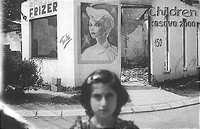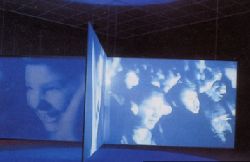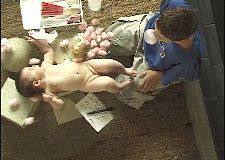
I Saw Virgins (Moving in From All Directions)
by Friederike Anders
(Click here for printer-friendly version)
Part 1: Childlike actresses at Berlinale or how to succeed as a young female professional in the media
During the last days of Berlinale, I saw some ravaging beauties on film who were all children.
 It
began with a film called Deza/Femjet
(the Serb/Albanian word for "children").
Made by a Hungarian director for Hungarian
and Belgian TV with support by the
George Soros fund, it claimed to do
something "new" by just "showing what´s
there" instead of investigating all
too complicated backgrounds. In this
case, it meant presenting beautiful
children with sad stories that wouldn´t
fail to make them shed some tears
into the devouring telefoto lens of
the art-documentarist. The icon of
innocence, wettened by the cum-shot
of journalism. Read:
Closeup of the big authentic teardrop
...
It
began with a film called Deza/Femjet
(the Serb/Albanian word for "children").
Made by a Hungarian director for Hungarian
and Belgian TV with support by the
George Soros fund, it claimed to do
something "new" by just "showing what´s
there" instead of investigating all
too complicated backgrounds. In this
case, it meant presenting beautiful
children with sad stories that wouldn´t
fail to make them shed some tears
into the devouring telefoto lens of
the art-documentarist. The icon of
innocence, wettened by the cum-shot
of journalism. Read:
Closeup of the big authentic teardrop
...
How can I be so cynical? Because I´m a film editor; that is, I work in propaganda. I know exactly how to employ these images to render an audience fatalistically, comfortably helpless, and I know it´s hard to resist using these means of manipulation since they never fail to produce the desired result: EMPATHY, or hunger for ever more spectacle. This is now cleverly labeled AUTHENTICITY, and, producing the symptoms of addiction, will be useful for marketing just any product.
Two girls left me doubtful.
They were not sufficiently authentic, even and especially for my callous taste.
Enter a nymphet nursing yeast dough to make some pastries for her family. After thus having introduced her as the one who cares for her loved ones even in conditions of post-war trauma she sits with her two younger brothers on a sofa and says nothing until asked. All three kids are very cute looking, but she´s an angel. A very fragile Nastassja Kinski with long eyelashes and shivering lips. When asked about that awful day when her dad the KLA fighter was killed by Serb militiamen she dramatically bursts out into tears or actually she bursts out without tears. The absence appears particularly odd after the torrents of tears presented until now.
Is this the paradoxical climax in the economy of tears for film -- NO tears instead of a steady sprinkle, as ultimate authentic proof of horror beyond imagination? If documentarism were pornography, it wouldn´t work. Customers would feel cheated.
Just as we´ve grown accustomed to accept an ejaculation (in front of the camera) as proof of true sex, then tears are the proof (or fetish) of true suffering. And where I don´t see tears, I recognize aspiring professional actresses at work. And maybe virgins on film are just the best proof of how professional performance is the most important ingredient in creating the convincing image of holy eternal sexy innocence; the image of VULNERABILITY.
The second girl actress / media professional in this film is even younger; maybe 11 years old. She looks like a perfect doll; complete with one of these tight throat-band-necklaces made of braided hair so fashionable with teen-girls in the late nineties - her neck is swan-like, her eyes shine like Bambi´s, and her hair is combed back in a very sleek adult hairdo. She works as a news presenter for an Albanian radiostation in Kosovo (Mitrovica) for a programme that asks Albanian children to speak out about their hate against Serbs. It´s her job to first make them reveal their private tragedies and then make them summarize how they´ve sworn revenge; and even though her voice is a little mechanical and monotone, she´s shown as absolutely aware and in charge. She´s producing the desired result with utmost efficiency.
She does as she is told and makes no mistakes. Isn´t that what makes a so-called professional ?
Next was the Japanese film Hole in The Sky. No party-politics, no media -- just another very young female acting out a specific role.
 It´s
a beautiful melancholic slo-mo study
about the temporary encounter between
an older lonesome male and a young
lonesome girl as the catalyst for
his character development. Of course
their supposed romance is triggered
by her innocent beauty and her youth
AND her puppetlike objecthood
which becomes more intense and obvious
after she brakes her ankle in a fit
of inexplicable girlish extasy : wanting
to look at the stars, she just kind
of jumps off the roof of the "Hole
in the Sky"-motor-lodge.
(Read: Impulsiveness
that can´t control itself. Purity
of feminine emotion proven by shattered
bones. A victim of herself from now
on to be carried around on her lovers
back because she can´t walk by herself
anymore.)
It´s
a beautiful melancholic slo-mo study
about the temporary encounter between
an older lonesome male and a young
lonesome girl as the catalyst for
his character development. Of course
their supposed romance is triggered
by her innocent beauty and her youth
AND her puppetlike objecthood
which becomes more intense and obvious
after she brakes her ankle in a fit
of inexplicable girlish extasy : wanting
to look at the stars, she just kind
of jumps off the roof of the "Hole
in the Sky"-motor-lodge.
(Read: Impulsiveness
that can´t control itself. Purity
of feminine emotion proven by shattered
bones. A victim of herself from now
on to be carried around on her lovers
back because she can´t walk by herself
anymore.)
By falling off the roof, she makes him fall in love for the first time in his life, allowing him to grow up and leave his childhood-trauma behind ... but what´s in this for her ? Can she grow up too? And gracefully?
 We´ve
all heard about the Japanese male
obsession with schoolgirls in uniforms.
Now in this film, there´s a funny
confrontation that shows us that even
the most childish irresponsibility
of the heroine might still not be
enough for male consumers. Specifically,
her new boyfriend tells her to set
things straight with her old boyfriend
who abandoned her penniless in the
middle of nowhere. After much cajoling,
she finally does as she is told, and
finds out the reason why she was dumped.
She finds another girl in her old
boyfriends car -- a child wearing
a school-uniform! Her former boyfriend
frankly admits his attraction to the
more virgin virgin. He felt
so "sorry" for her because she was
"alone" and "helpless".
We´ve
all heard about the Japanese male
obsession with schoolgirls in uniforms.
Now in this film, there´s a funny
confrontation that shows us that even
the most childish irresponsibility
of the heroine might still not be
enough for male consumers. Specifically,
her new boyfriend tells her to set
things straight with her old boyfriend
who abandoned her penniless in the
middle of nowhere. After much cajoling,
she finally does as she is told, and
finds out the reason why she was dumped.
She finds another girl in her old
boyfriends car -- a child wearing
a school-uniform! Her former boyfriend
frankly admits his attraction to the
more virgin virgin. He felt
so "sorry" for her because she was
"alone" and "helpless".
Jealousy makes the heroine an adult woman in an instant. Her naivete, which was celebrated as the equivalent of her personality, is gone. Now all her wonderful quirky grimaces and abrupt changes of mood no longer represent lovable girlishness but sad womanhood, adorable only when fractured physically ... The only possibility for her to save face is to leave, submerge back into oblivion, and make her new boyfriend sad as well.
The only girls who don´t have to cry or break their bones in order to get past that last interesting moment in a girls' life for film are younger still. Enter the little 5 or 7-year-old beauty in Doug Aitken's big imposing video-sculpture/installation I am in You currently on display in Kunstwerke. "In who"? Well, the heroine of this piece is both the literally sleeping beauty carted away with her bed along with her entire "home" which is a big stage-prop/ Dan Graham-artpiece thing on a dark highway on a big truck - a very nice and dreamy image.
 At
the same time, she´s also the little
tinkerbell fairy who repeats the mantra-like
words of the author (e.g. "You can´t
stop" and "You gotta be smart"). Set
on 6 or 8 screens simultaneously inside
of a custom-built, felt-isolated plywood
chapel of projections, it reverberates
from rhythmic clapping and whispering
sounds and produces a very hypnotic
athosphere - with the girlchild as
the priestess of this MTV-schooled
auteur who sells so well in the artworld.
At
the same time, she´s also the little
tinkerbell fairy who repeats the mantra-like
words of the author (e.g. "You can´t
stop" and "You gotta be smart"). Set
on 6 or 8 screens simultaneously inside
of a custom-built, felt-isolated plywood
chapel of projections, it reverberates
from rhythmic clapping and whispering
sounds and produces a very hypnotic
athosphere - with the girlchild as
the priestess of this MTV-schooled
auteur who sells so well in the artworld.
Can you get even younger then, Miss Anima? Yes ! I now remember the archetype. An artschool friend proudly presented her one day as his "image of a young woman". She was blond, she had Grace Kelly's eyes and a seductive all-knowing smile on her face, lying on a soft cushion. She was the baby girl on the front of a box of Pampers.
Part 2: Girl Power, revisited - the candid eye
I saw virgins - a lot of them were on display at Videonale. Also saw some at Oberhausen. They made me rethink certain comfortable leftist/feminist indictments of the malignant fetishization of youth and beauty. Unlike the pathetic symbolist setups I saw earlier at Berlinale and Kunstwerke, these very young women performed to reveal something new in the midst of the familiar, a totally daring and unusual perspective on a world of unexplained trivia, rich with hopes and aspirations about truth and the future.
Yet all these works had one thing in common -- the seemingly unoriginal choice of beautiful young females for protagonists. But why were these new works so different, so exciting? There´s no simple answer, but all of them happened to be made by women directors who appear to share a certain sceptical, inquisitive, yet humorous viewpoint both true to documentary form and to a surrealist sensitivity for nuances in atmosphere.
 For
instance, consider the ravishing young
beauties from the Viennese housing
projects in Ruth Kaaserer's
Balance. They reminded
me Eija Lisa Ahtila´s reflections
on and with pubescent girls in if
6 was 9, or of Vibeke Tandberg's
Sportsclass and of Tracey
Moffat's Girl-ballgamers
... The latter also shows a fascination
with sports and girls; and "balance"
at first sight comes on like a Benetton
ad because it features youth, sweat
and fashion, but it lets the girls
speak for themselves and succeeds
to change the perspective from being-looked-at-ness
to looking. However insecure or even
banal the insights might turn out,
they are proof of their uncensored
authenticity.
For
instance, consider the ravishing young
beauties from the Viennese housing
projects in Ruth Kaaserer's
Balance. They reminded
me Eija Lisa Ahtila´s reflections
on and with pubescent girls in if
6 was 9, or of Vibeke Tandberg's
Sportsclass and of Tracey
Moffat's Girl-ballgamers
... The latter also shows a fascination
with sports and girls; and "balance"
at first sight comes on like a Benetton
ad because it features youth, sweat
and fashion, but it lets the girls
speak for themselves and succeeds
to change the perspective from being-looked-at-ness
to looking. However insecure or even
banal the insights might turn out,
they are proof of their uncensored
authenticity.
The mere sound of their shy, halting voices stands out in a subtle way. One hears the girls talking about their futures, and everything seems almost familiar except for one minor difference. Actually, this difference is nothing less than an inversion of the standard performance of girls on film. That is, they actually get to talk and everything is done from their own POV. By allowing them impromptu but mildly staged appearances at locations of their own choosing, a coy exhibition is acted out. They become performers of their own lifes, playfully appropriating a space of their own in a men's world of sporting, gaming and self-acclaimed coolness.
And thus the audience gets treated to a rare first-hand insight into the virgin experience as encircled, hidden and almost erased by social and media-induced stereotyping. The fact that the young protagonists are actually double-outsiders because of their status as immigrants isn´t brought up as a special topic but simply appears as an aspect of their documented everyday-life, encoded through dress codes and musical preferences (e.g. hiphop).
Giving them a stage also means redefining some notions of documentary filmmaking. By having them redo their lines, several times when shooting to arrive at the best version, documentary truth becomes both more of a performance and much less of a voyeurist spectacle (as, for instance, in the devouring pursuit of reality achieved by Dogma-tist DV-filming). As simple a trick as it seems, this mirroring of the view, in the highly fine-art-drenched frame of Videonale shone both like a brilliant conceptualist twist and a necessary shift of attention to the margins.
Even more intriguing and certainly more overtly disturbing was Miranda July´s Nest of Tens, presented at the international competition programme at Oberhausen. Honoured both with the with the 2nd price of the city of Oberhausen and North-Rine-Westfalia´s price of the minister of culture, this piece would remain completely opaque if read with the eyes and vocabulary of the trained Hollywood-dramaturgist.
 Miranda
July shows us a strange (slightly
deranged and Al-Bundy-esque) lower
middle class suburban group of people
including kids, that doesn´t behave
like a family. Noone plays the part
of "mom" or "dad"; no one cares, especially
not the grown-ups. For the most part,
only the kids show a keen sense of
curiosity about their co-humans, although
not in a too affectionate and warm-hearted
way, though. The group consists of
a young blonde woman, her older wannabe-boyfriend(?),
a baby girl and two older kids. The
two older kids (a boy of maybe 8 years
and a girl of maybe 10) may be the
siblings of the baby but are definitely
not the kids of the too young blonde.
Miranda
July shows us a strange (slightly
deranged and Al-Bundy-esque) lower
middle class suburban group of people
including kids, that doesn´t behave
like a family. Noone plays the part
of "mom" or "dad"; no one cares, especially
not the grown-ups. For the most part,
only the kids show a keen sense of
curiosity about their co-humans, although
not in a too affectionate and warm-hearted
way, though. The group consists of
a young blonde woman, her older wannabe-boyfriend(?),
a baby girl and two older kids. The
two older kids (a boy of maybe 8 years
and a girl of maybe 10) may be the
siblings of the baby but are definitely
not the kids of the too young blonde.
 Besides
the unexplained family-relations,
nothing very extraordinary happens.
They watch TV. The wannabe-boyfriend
wants to get it on with the blonde
and can even be seen jerking himself
off a bit while the blonde tries to
keep both him and the clinging and
pestering younger girl at bay by telling
a long and pointless story, Sheherezade-style.
Meanwhile, in another room, the boy
exercises a cleansing-ritual with
the baby-girl treating her genitals
with kitchen detergents; then proceeds
to play astronaut or something where
remote control and pressing little
paper-cutout-numbers attached to his
and the baby girl's body plays an
important role.
Besides
the unexplained family-relations,
nothing very extraordinary happens.
They watch TV. The wannabe-boyfriend
wants to get it on with the blonde
and can even be seen jerking himself
off a bit while the blonde tries to
keep both him and the clinging and
pestering younger girl at bay by telling
a long and pointless story, Sheherezade-style.
Meanwhile, in another room, the boy
exercises a cleansing-ritual with
the baby-girl treating her genitals
with kitchen detergents; then proceeds
to play astronaut or something where
remote control and pressing little
paper-cutout-numbers attached to his
and the baby girl's body plays an
important role.
In a narrative sense, there´s neither "story" nor "character-development", and from a symbolist view-point, no access can be gained, either. There doesn´t seem to be a "point" or an easy one-to-one translation. But try looking at this like at a reality-soap without rules. Try looking at it as a series of scenes from REAL LIFE. It only takes a little magic twist of attention, a little refocussing and loosening of the eyes, and, as with certain confusing 3D-pattern-prints, a second embedded image will pop up and be there as long as you can hold the focus like the strange ghosts faces and figures the little girl sees in paper cutouts or like the shape of a vulva appearing on her specially handpressed arm
It´s through the subtle, quasi-documentary depiciton of the kids' play, but especially through the views and positions of the less self-sufficient and more critical girl, that the refocusing of this bland scenery sets in and the embedded motif appears. It consists in the spectre of clairvoyant virginity, guiding us through a hidden garden of unspeakable feminine obsessions ... And this is the reason for my fascination with Miranda July's piece -- it made me realize that there really is something more to the undeflowered female view of the world than the entirely boring "secret" of virginity as presented by media-products like Britney Spears.
The closer the virgins approach the once-in-a-lifetime act of defloration as the supposed culmination/ realization of their young life's raison d'etre (also representing the end of their status as romantic heroine in the structure of patriarchal drama), the more keenly aware they become of social strucures and patterns of sexuality perceived as their destiny. They now enjoy the rare opportunity to actually become a medium for these supposedly purely instinctive patterns of sexual behaviour; "channeling" anybody who is brave enough to keep their eyes open directly down to the bare roots of the actual construction of "fate".
William Friedkin got close to the virgin mystique but needed horror for his own defense. Bunuel has always been daring enough to bravely honestly and fantastically confront it. But nowadays it seems to become a noble sport and favorite pastime for the incredibly gifted female filmmaker. Catherine Breillat would be a chief-witness for this thesis but that would be a whole new chapter.
Friederike Anders, 11.5.2001/11.6.2001